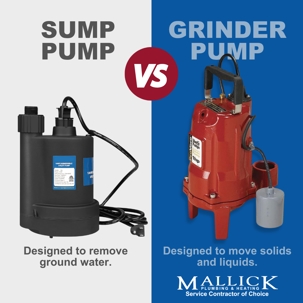
In the realm of plumbing and home maintenance, it’s crucial to be aware of the various systems that work together to keep your home dry and comfortable. Two essential components often found in homes with basements are sump pumps and grinder pumps. While both play a pivotal role in preventing water damage, they serve different purposes and are designed for distinct applications.
Sump Pumps: A Shield Against Basement Flooding
Sump pumps are the unsung heroes of many basements, silently guarding against potential flooding disasters. Installed in a pit or basin commonly referred to as a sump pit, these pumps activate when water levels rise above a certain point. Their primary function is to pump excess water away from the foundation of the house, preventing water damage and basement flooding.
Sump pumps are especially crucial in areas prone to heavy rainfall or where the water table is high. They come in two main types: submersible and pedestal. Submersible pumps are installed directly in the sump pit, submerged in water for efficient operation. On the other hand, pedestal pumps are mounted above the pit, with only the impeller and motor in the water.
Regular maintenance is essential for sump pumps to ensure they function optimally when needed. Checking for debris, testing the pump, and ensuring proper discharge are routine tasks that homeowners should perform to keep their sump pump in top condition.
if you have any questions about your Sump Pump, please contact us at (301) 804-6759 for immediate assistance!
Grinder Pumps: Navigating Through Solid Waste
While sump pumps focus on handling excess water, grinder pumps are designed to navigate through solid waste, making them a crucial component in homes connected to a municipal sewage system. Grinder pumps are commonly found in homes that are below the level of the municipal sewer line.
Unlike traditional sewage ejector pumps, grinder pumps have a cutting mechanism that shreds solid waste into smaller particles before pumping it into the main sewer line. This unique feature allows grinder pumps to handle items that may clog or damage other pump systems, such as wipes, diapers, and other non-biodegradable materials.
Grinder pumps are typically installed in a tank called a grinder basin, where the cutting mechanism reduces solid waste to a slurry that can be easily pumped through the sewer line. Regular maintenance, including checking for clogs and ensuring the cutting blades are in good condition, is crucial to the efficient operation of grinder pumps.
Suspect an issue with your Grinder Pump? Please contact us at (301) 804-6759 for help from our expert technicians.
Choosing the Right Pump for Your Needs
When it comes to selecting the right pump for your home, it’s essential to consider the specific requirements of your plumbing system. If you live in an area prone to flooding or have a basement that experiences water accumulation, a sump pump is the ideal choice. On the other hand, if your home relies on a grinder pump for sewage disposal, it’s crucial to be mindful of what can and cannot be flushed down the drains.
In conclusion, both sump pumps and grinder pumps play vital roles in maintaining a dry and functional home. Understanding their differences and the specific needs they address is key to making informed decisions about your plumbing system. Regular maintenance and professional inspections ensure that these pumps operate efficiently, providing you with peace of mind and a safeguard against potential plumbing issues.
If you have any questions or concerns about your Sump Pump or Grinder Pump, please give our team a call at (301) 804-6759 for immediate assistance!
